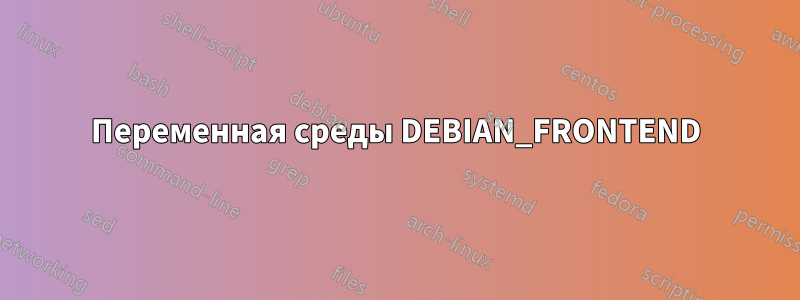
Мой потенциальный хостинг-провайдерпредполагаетзапустить команду в терминале, чтобы сделать образ ОС сервера на базе KVM минимальным. Поскольку их шаблоны KVM поставляются с пакетами, которые мне не понадобятся, я подумал, что могу использовать ту же команду для удаления нежелательных пакетов.
Эта команда начинается с DEBIAN_FRONTEND=noninteractive, а затем вызывается apt-get removeследующим образом:
DEBIAN_FRONTEND=noninteractive apt-get remove --purge -y -o Dpkg::Options::="--force-confdef" -o Dpkg::Options::="--force-confold" package-1 package-2 ... package-n; apt-get -y autoremove; apt-get clean all
Это первый раз, когда я сталкиваюсь с DEBIAN_FRONTENDпеременной окружения, и я не смог найти полезной информации до сих пор. Поэтому мне интересно, что делает ее установка noninteractive, и целесообразно ли это, потому что я предполагаю, что значение ( noninteractive) сохранится.
решение1
Простое добавление к aptкоманде символа DEBIAN_FRONTEND=somethingне сохраняется после той единственной команды, к которой он применен.
Параметры DEBIAN_FRONTENDописаны на страницах руководства в разделе 7 debconf(вам может потребоваться установить пакет debconf-doc, чтобы сделать их доступными в вашей системе). Из man 7 debconf:
Frontends
One of debconf's unique features is that the interface it presents to
you is only one of many, that can be swapped in at will. There are many
debconf frontends available:
dialog The default frontend, this uses the whiptail(1) or dialog(1)
programs to display questions to you. It works in text mode.
readline
The most traditional frontend, this looks quite similar to how
Debian configuration always has been: a series of questions,
printed out at the console using plain text, and prompts done
using the readline library. It even supports tab completion. The
libterm-readline-gnu-perl package is strongly recommended if you
chose to use this frontend; the default readline module does not
support prompting with default values. At the minimum, you'll
need the perl-modules package installed to use this frontend.
This frontend has some special hotkeys. Pageup (or ctrl-u) will
go back to the previous question (if that is supported by the
package that is using debconf), and pagedown (or ctrl-v) will
skip forward to the next question.
This is the best frontend for remote admin work over a slow con‐
nection, or for those who are comfortable with unix.
noninteractive
This is the anti-frontend. It never interacts with you at all,
and makes the default answers be used for all questions. It
might mail error messages to root, but that's it; otherwise it
is completely silent and unobtrusive, a perfect frontend for
automatic installs. If you are using this front-end, and require
non-default answers to questions, you will need to preseed the
debconf database; see the section below on Unattended Package
Installation for more details.
В нем также отмечается, что:
You can change the default frontend debconf uses by reconfiguring deb‐
conf. On the other hand, if you just want to change the frontend for a
minute, you can set the DEBIAN_FRONTEND environment variable to the
name of the frontend to use. For example:
DEBIAN_FRONTEND=readline apt-get install slrn
The dpkg-reconfigure(8) and dpkg-preconfigure(8) commands also let you
pass --frontend= to them, followed by the frontend you want them to
use.
Note that not all frontends will work in all circumstances. If a fron‐
tend fails to start up for some reason, debconf will print out a mes‐
sage explaining why, and fall back to the next-most similar frontend.



